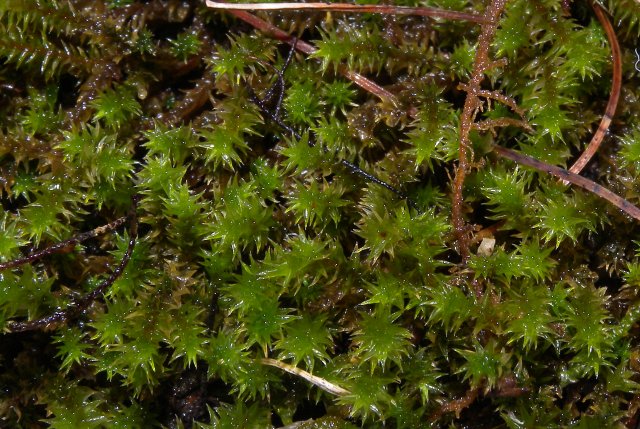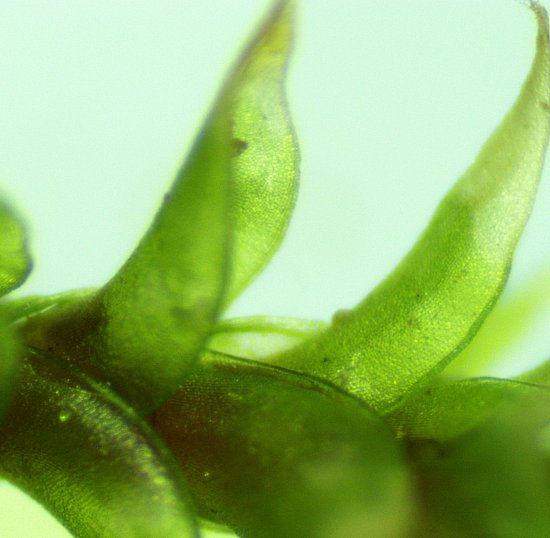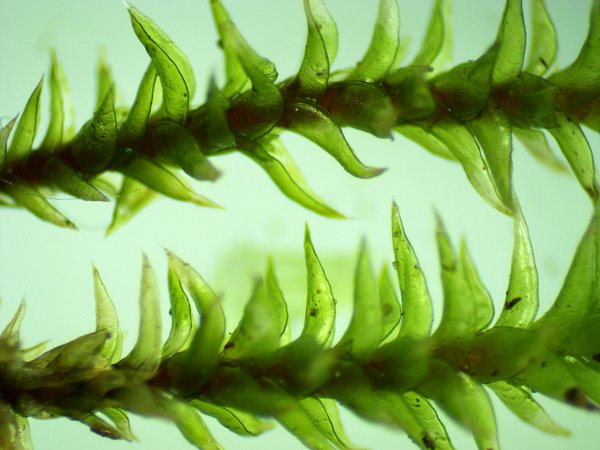
This moss is monoicous, producing male reproductive organs (antheridia) and female reproductive organs (archegonia) at the tips of different branches on the same plant during the spring. After the sperm have fertilized the ovae, spore-bearing capsules develop that are nearly sessile. The capsule bodies with their lids (opercula) are about 1.5 mm. in diameter, ovoid-globoid in shape, and pale brown to reddish brown when they are mature. The lids are very shallow; they are flat on the bottom, and low convex-conical above. White-membranous hoods (calyptrae) cover the capsule bodies and their lids initially, but they soon split apart and fall to the ground. Eventually, the lids detach from their capsules, releasing the spores to the wind. There are no rings of teeth surrounding the openings of the capsules. Individual spores are 20-30 micrometers across, globoid-angular in shape, and minutely bumpy (papillose). Individual plants become attached to the substrate when their stem bases and lower stems develop fibrous rhizoids. Asexual reproduction is possible when fragments of leafy stems, resulting from some kind of disturbance, develop new fibrous rhizoids that attach themselves to the substrate.

Cultivation: The preference is full sun to light shade, moist to dry conditions, and acidic rocks or rocky material for a substrate. However, this moss can also tolerate limestone or dolomite with a higher pH. It can also adapt to such surfaces as roofing material, barren soil, and logs. This moss is more tolerant of sunlight and dry conditions than most moss species, making it a good candidate for rock gardens and green rooftop gardens.
Range & Habitat: The native White-tipped Moss (Hedwigia ciliata) is occasional in NE Illinois, east-central Illinois, and southern Illinois, while in the rest of the state it is uncommon or absent (see Distribution Map). This moss is widely distributed throughout the world, including North America, South America, Eurasia, Africa, and Australia. In Illinois, habitats include sandstone walls in canyons, sandstone bluffs and rocky ridges, faces of limestone rocks, steep slopes of ravines in woodlands, rocks and boulders along woodland trails, rocks and boulders along woodland streams and springs, steep banks along creeks, rocks along ponds, pockets of sandy clay on sandstone outcrops, sandstone glades, exposed rocky hills, old stone walls of churches and other property, areas along the foundations of buildings, old shingle roofs on cabins, and asphalt roofs on buildings. Outside of the state, this moss has been found on the lower trunks of trees. In general, this moss prefers to grow on acidic rocks in either upland open woodlands or inside canyons, but it also grows on hard grainy surfaces in urban and residential areas.

Faunal Associations: The Barn Swallow, American Robin, Least Flycatcher, Dark-eyed Junco, and other songbirds occasionally use fragments of this moss in the construction of their nests (Breil & Moyle, 1976).
Photographic Location: Indoors using nursery-cultivated plants. Close-up photos were taken with a microscope.
Comments: White-tipped Moss (Hedwigia ciliata) is variable in appearance depending on the amount of translucent whiteness toward the tips of its leaves and whether or not conspicuous white bristles occur at the tips of its leaves. Generally, specimens of this moss in eastern North America have leaves with only a small region of translucent whiteness at their leaf tips with little or no bristles. As the leaves age, however, they become more white-translucent before withering away. White-tipped Moss can be distinguished from other similar mosses by its white-tipped and sometimes bristly leaves, the absence of midribs on its leaves, the revolute margins on its leaves (at least along their lower margins), the minute bumpiness of its leaf cells, and its sessile or nearly sessile globoid spore-capsules. Also, unlike many mosses, White-tipped Moss prefers to grow on relatively dry and exposed rocks, even rooftops. Other common names of this moss include Fringed Hoar Moss, Ciliate Hedwigia Moss, Hedwig's Fringeleaf Moss, and Medusa Moss. There are no other moss species in the Hedwigia genus in Illinois.